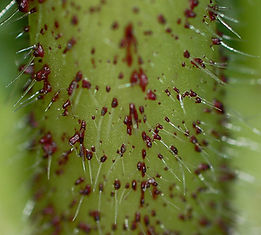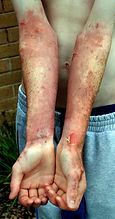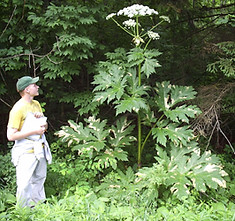

Ireland: Kerry - Dublin - Cork - Waterford - Roscommon - Galway - Belfast
UK: London - Manchester - Newcastle - Cardiff - Liverpool
Giant Hogweed - Invasive Species Information


What Is Giant Hogweed - (Heracleum mantegazzianum)?
Habitat: commonly found along streams, ditches, roadsides and wet meadows.
Distribution in Ireland: Widespread
Status: Established
Family name: Apiaceae


Reproduction: Giant hogweed produces 1,500 to 100,000 seeds per plant. These are coin sized and paper thin. Some can be spread by the surface run-off of rain or in the wind. A small number of seeds can even be transported unintentionally by humans or livestock if trampled upon. Giant hogweed seeds can remain viable in the soil for up to 15 years.
Giant hogweed toxic spines
Giant hogweed leaf
Giant hogweed is an invasive biennial or perennial plant species which is native to the Caucasus Mountains at the border of Europe and Asia. It was introduced to Ireland in the 19th Century as an ornamental garden plant. Since then, it has escaped into the wild and is scattered throughout the country. Giant hogweed prefers in rich, moist soil.

Giant hogweed in flower
How To Identify Giant Hogweed?
Leaf: Leaf edges are very coarse and serrated
Flowers: Look like very large Cow parsley
Stem: Fine (toxic) hairs grow from red spots
Size: Can grow up to between 3-5 metres high




Giant hogweed seeds
Giant hogweed - Heracleum mantegazzianum ID Guide
Giant hogweed in winter
Giant hogweed stem
Why Is Giant Hogweed A Problem?
Giant hogweed is considered to be a significant danger to public health. The stems, edges and undersides of the leaves are coated with fine hairs containing phototoxic sap*. The slightest contact with human skin can cause severe dermatitis in the presence of sunlight. Effects may include welts, rashes, and blistering.
The sap* can also cause temporary or permanent blindness following contact with eyes. If skin comes into contact with Giant hogweed the affected area should be covered immediately from sunlight.
The skin should then be washed with cold water and medical advice should be sought as soon as possible. Giant hogweed can invade farm and forestry land, reducing available agricultural area and biodiversity.
Animals grazing Giant hogweed may be susceptible to poisoning or digestive disorders. Ingestion of Giant hogweed is known to interfere with the fertility of female livestock.
Due to the serious health risks associated with Giant hogweed, it is recommended that all methods of control are carried out by trained and experienced personnel.


Giant hogweed is an invasive species which is extremely difficult to eliminate from a site. The control of Giant hogweed should aim to eradicate the plant entirely or at a minimum, prevent the plant from producing seed. A number control methods may be employed to exhaust the plant’s seed bank.
As the seeds remain viable for several years, control requires continued input and follow-up over a number of years.
Giant hogweed burns
Giant hogweed in flower
*Sap/Juices contain Furanocoumarin.
Furanocoumarins, or furocoumarins, are a class of organic chemical compounds produced by a variety of plants. They are biosynthesized partly through the phenylpropanoid pathway and the mevalonate pathway, which is biosynthesized by a coupling of dimethylallyl pyrophosphate (DMAPP) and 7-hydroxycoumarin (umbelliferone).
Many furanocoumarins are toxic and are produced by plants as a defense mechanism against predators such as insects and mammals. This class of phytochemical is responsible for the phytophotodermatitis seen in exposure to the juices of the wild parsnip and the giant hogweed..
Medication interactions:-
Furanocoumarins have other biological effects. For example, in humans, bergamottin and 6',7'-dihydroxybergamottin are responsible for the "grapefruit juice effect", in which furanocoumarins affect certain P450 liver and gut enzymes, such as the inhibition of CYP3A4 which either activates or deactivates many drugs, leading to higher or lower levels in the bloodstream.
Furanocoumarins have various effects which can specifically increase or decrease (depending on the drug) the blood levels of many pharmaceuticals in ways that can be life-threatening. Approved drugs will include warnings for grapefruit.
European Communities (Birds and Natural Habitats) Regulations 2011 non-native invasive plant species A-Z (Updated 2017)
There are currently 35 invasive plant species listed in the European Communities (Birds and Natural Habitats) Regulations (annex 2, Part 1)...
Click on a species from the following list to find out more regarding non-native species subject to restrictions under Regulations 49 and 50.
-
American Skunk-Cabbage - Lysichiton americanus
-
Brazilian Giant-Rhubarb - Gunnera manicata
-
Broad-Leaved Rush - Juncus planifolius
-
Cape Pondweed - Aponogeton distachyos
-
Cord-Grasses - Spartina (all species and hybrids)
-
Curly Waterweed - Lagarosiphon major
-
Dwarf Eel-Grass - Zostera japonica
-
Fanwort - Cabomba caroliniana
-
Floating Pennywort - Hydrocotyle ranunculoides
-
Fringed Water-Lily - Nymphoides peltata
-
Giant Hogweed - Heracleum mantegazzianum
-
Giant Knotweed - Fallopia sachalinensis
-
Giant-Rhubarb - Gunnera tinctoria
-
Giant Salvinia - Salvinia molesta
-
Himalayan Balsam - Impatiens glandulifera
-
Himalayan Knotweed - Persicaria wallichii
-
Hottentot-Fig - Carpobrotus edulis
-
Japanese Knotweed - Fallopia japonica
-
Large-Flowered Waterweed - Egeria densa
-
Mile-a-Minute Weed - Persicaria perfoliata
-
New Zealand Pigmyweed - Crassula helmsii
-
Parrots Feather - Myriophyllum aquaticum
-
Red Alga - Grateloupia doryphora
-
Rhododendron - Rhododendron ponticum
-
Salmonberry - Rubus spectabilis
-
Sea-Buckthorn - Hippophae rhamnoides
-
Spanish Bluebell - Hyacinthoides hispanica
-
Three-Cornered Leek - Allium triquetrum
-
Wakame - Undaria pinnatifida
-
Water Chestnut - Trapa natans
-
Water Fern - Azolla filiculoides
-
Water Lettuce - Pistia stratiotes
-
Water-Primrose - Ludwigia (all species)
-
Waterweeds - Elodea (all species)
-
Wireweed - Sargassum muticum
Non-Native Plant Species identified as High Risk on Ireland's Biodiversity List...
Common name
Species name
Fallopia x bohemica
Elodea canadensis
Prunus laurocerasus
Gunnera tinctoria
Spartina anglica
Lagarosiphon major
Hydrocotyle ranunculoides
Nymphoides peltata
Heracleum mantegazzianum
Fallopia sachalinensis
Impatiens glandulifera
Carpobrotus edulis
Undaria pinnatifida
Fallopia japonica
Crassula helmsii
Elodea nuttallii
Myriophyllum aquaticum
Rhododendron ponticum
Ludwigia grandiflora
Sargassum muticum
Environment
Terrestrial
Freshwater
Terrestrial
Terrestrial
Marine
Freshwater
Freshwater
Freshwater
Terrestrial
Terrestrial
Terrestrial
Terrestrial
Marine
Terrestrial
Freshwater
Freshwater
Freshwater
Terrestrial
Freshwater
Marine
Risk score
20
19
18
19
18
19
21
20
19
18
18
19
19
20
20
19
20
20
20
18